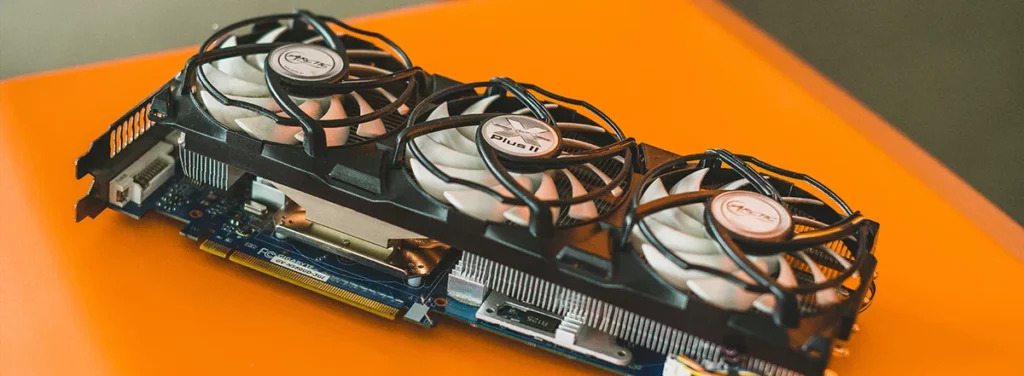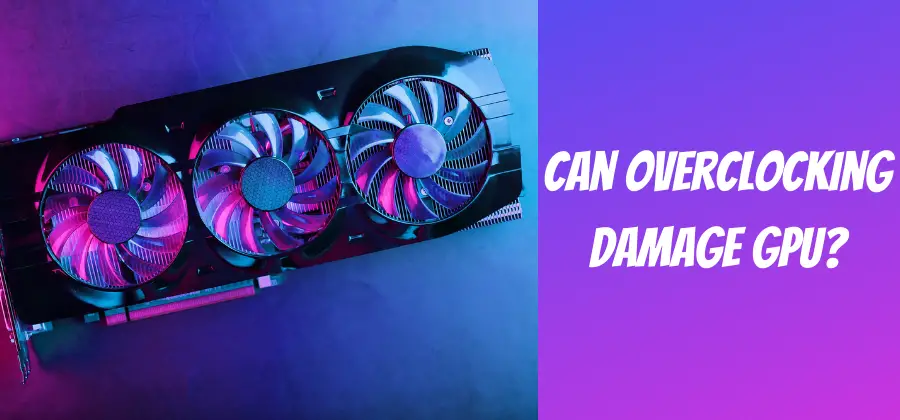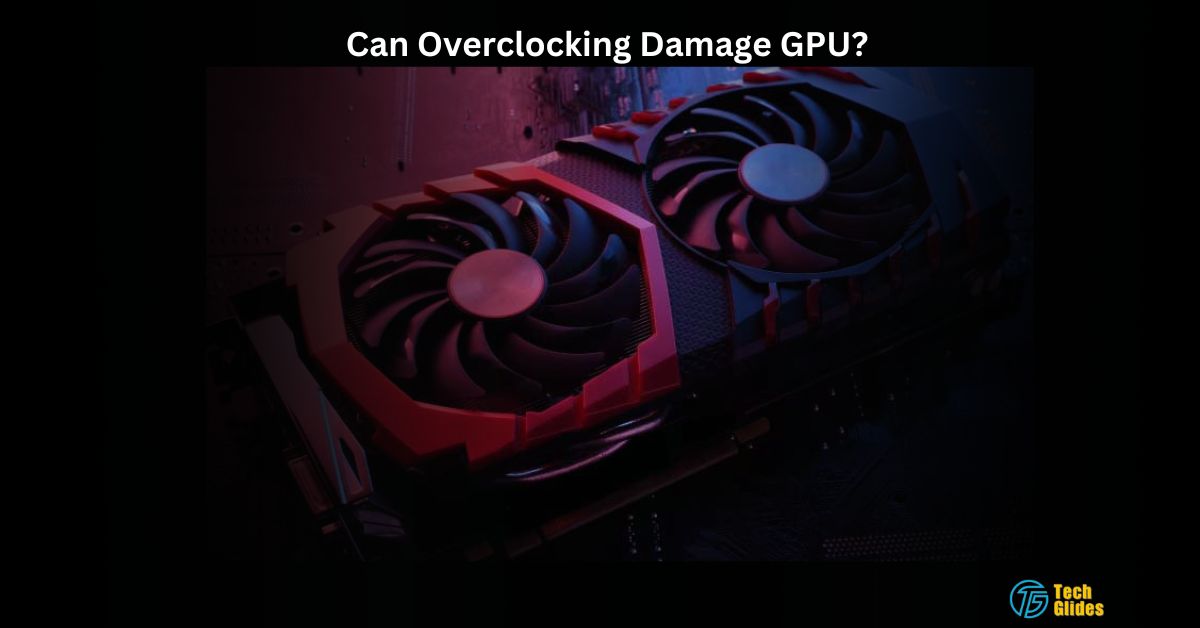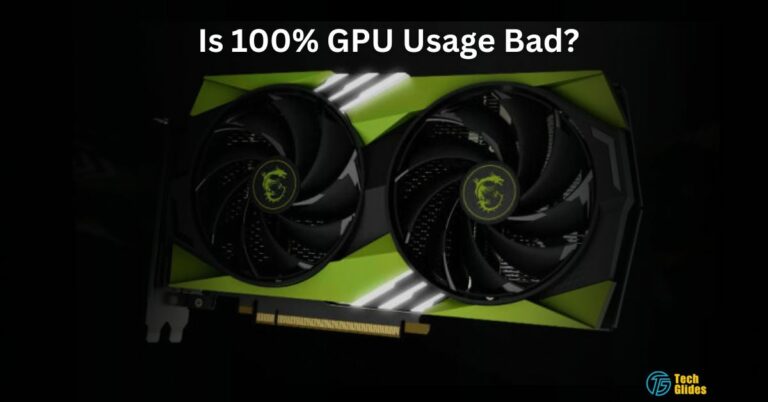Can Overclocking Damage GPU? – Yes Or No!
Overclocking has become a popular practice among tech enthusiasts looking to squeeze extra performance from their hardware. However, a common concern that arises is whether overclocking can potentially damage the Graphics Processing Unit (GPU).
Normally, Overclocking will not damage your GPU when done correctly. But Pushing a graphics card beyond its designed limits may lead to overheating, instability, and reduced lifespan.
Let me explain each and everything that you should know before proceeding with this system. In this article, we’ll delve into the intricacies of GPU overclocking, exploring what it means, how it affects your system, and whether it poses a risk to your valuable graphics card.
Contents
- What Does Overclocking Mean In GPU? – Clear Some Basics First!
- How Does Overclocking Damage The GPU? – Stop Your System From Destroying!
- What Do You Need to Overclock Your GPU Correctly?
- How to Overclock GPU Safely to Avoid Damage? 10 Proven Steps!
- What Are the Most Common Mistakes When Overclocking?
- Some Precautions To Avoid GPU Damage While Overclocking
- What Did My Friend Do When Highly Overclocking Damaged His Gpu?
- Damaged GPU from 150MHz Overclock? – Let’s Fix It!
- GPU Memory Overclock Damage?
- What Does a GPU Do for Gaming?
- Pros And Cons Of Overclocking GPU – Take Analysis!
- Frequently Asked Questions
- 1. Can Overclocking Break a Graphics Card?
- 2. Can You Damage a GPU with Afterburner?
- 3. Does Overclocking Reduce GPU Lifespan?
- 4. Will Overclocking GPU Increase FPS?
- 5. Can Overclocking Damage Motherboard?
- 6. Can Overclocking Core/Memory on a GPU Damage It?
- 7. Can Overclocking a GPU Be Harmful?
- 8. How to Maximize GPU Performance?
- 9. What Are the Signs of GPU Overheating?
- 10. Is GPU Overclocking Only for Gamers?
- 11. Does Overclocking Reduce Your GPU’s Life?
- Summing Up The Discussion
- Also Read:
What Does Overclocking Mean In GPU? – Clear Some Basics First!
Before delving into the potential risks, let’s clarify what overclocking entails. Overclocking is the process of pushing a component, in this case, a GPU, beyond its factory-set specifications to achieve higher performance.
In the GPU world, it means tweaking parameters such as clock speeds, voltages, and memory timings to make the graphics card work at a faster pace than what the manufacturer originally intended.
This is handy for gamers and those into graphics-heavy tasks like rendering, as it can lead to better performance.
However, it’s crucial to weigh the benefits against the potential risks of increased heat and possible damage, emphasizing the importance of responsible overclocking practices.
Must Check: Why Won’t My Laptop Charge? – All That You Seek!
Is Overlocking Important for your GPU?
Whether overclocking is important for your GPU depends on your specific needs and usage. Overclocking can provide a performance boost, making your GPU work faster and potentially improving gaming experiences or rendering times. However, it’s not universally essential, and there are risks involved, such as increased heat and the potential for damage if not done correctly.
For casual users, the factory settings may be sufficient, while enthusiasts or those with demanding tasks may find value in the extra power that overclocking can unlock. It’s a trade-off between enhanced performance and the responsibility to ensure your GPU remains stable and healthy.
Do You Know? Does Acer Nitro 5 Support USB-C Charging? – Find Out In 2024!

How Does Overclocking Affect the GPU of Your System?
While overclocking can boost GPU performance, it also generates more heat and increases power consumption. GPUs are designed with certain operating parameters in mind, and exceeding these can lead to instability and potential damage over time.
Is Overclocking Safe For Your GPU?
The safety of overclocking largely depends on how responsibly it’s done. When within reasonable limits and accompanied by proper cooling measures, overclocking can be safe. However, pushing the limits too far or neglecting cooling solutions can lead to adverse effects on your GPU.
Have You Explored? Can I Charge My Lenovo Laptop With A USB-C Phone Charger? – Detailed 2024 Answer!
How Does Overclocking Damage The GPU? – Stop Your System From Destroying!
Overclocking can potentially damage a GPU by putting it under increased stress. When you overclock, you’re essentially making the GPU work harder and faster than what it was originally designed for. This generates more heat, and if not properly managed, the excess heat can lead to problems. Think of it like asking your computer to run a marathon at a sprinter’s pace – it might do it for a while, but there’s a risk of overheating.
High temperatures can wear down the GPU over time, shortening its lifespan or, in extreme cases, causing immediate failure. Additionally, pushing the voltage too high during overclocking can result in electrical damage. So, while overclocking can boost performance, it’s essential to do it responsibly and with proper cooling to avoid potential harm to your GPU.
Recent Post: Can I Use A 19V Charger For A 19.5V Laptop? – Detailed 2024 Guide!
What Do You Need to Overclock Your GPU Correctly?
Overclocking requires careful consideration and the right tools. A robust cooling system, reliable overclocking software, and a good understanding of your GPU’s specifications are essential. Without proper knowledge and tools, you risk damaging your GPU.
- Quality GPU: Ensure your graphics card is designed for overclocking, as not all GPUs are created equal in this regard.
- Reliable Cooling System: Invest in an efficient cooling solution to manage the increased heat generated during overclocking.
- Overclocking Software: Choose a reputable overclocking software such as MSI Afterburner or EVGA Precision X1 to adjust GPU settings.
- Understanding GPU Specifications: Have a solid grasp of your GPU’s specifications, including a base clock, boost clock, and memory speed.
- Patience: Overclock gradually, making small adjustments at a time, and test stability to avoid sudden crashes.
- Benchmarking Tools: Use benchmarking tools like FurMark or 3DMark to assess the impact of overclocking on performance.
- Temperature Monitoring: Employ monitoring tools to keep a close eye on GPU temperatures and prevent overheating.
- Backup Settings: Save stable settings as a backup to quickly revert to in case of instability or issues.
- Power Supply Consideration: Ensure your power supply can handle the increased power demand from overclocking.
How to Overclock GPU Safely to Avoid Damage? 10 Proven Steps!
To overclock safely, start conservatively. Gradually increase clock speeds and monitor temperatures. Ensure adequate cooling with quality fans or liquid cooling solutions. Testing stability and ensuring the GPU stays within safe temperature and voltage ranges are crucial steps in safe overclocking.
1. Understand Your GPU:
Dive into the specifics of your GPU – know the base and boost clock speeds, the amount of VRAM it packs, and its architectural nuances. This knowledge sets the stage for realistic overclocking goals.
2. Quality Cooling Solution:
Treat your GPU to top-notch cooling. Whether it’s advanced air cooling or a liquid cooling setup, an efficient cooling solution is your first line of defense against the heat generated during overclocking.
3. Use Reliable Overclocking Software:
Pick a trustworthy overclocking tool like MSI Afterburner or ASUS GPU Tweak. These user-friendly interfaces let you tweak core clocks, voltages, and fan speeds with ease.
Latest Post: Why Does My Laptop Charger Get Hot – Come With Me!
4. Gradual Overclocking:
Take it slow. Incrementally adjust core clock and memory speeds. Test stability after each tweak using stress tests or benchmarking tools. It’s like finding the sweet spot without rushing.
5. Monitor Temperatures:
Keep a vigilant eye on your GPU’s temperature using monitoring tools. Overheating is like a silent threat – it can lead to throttling, decreased performance, or, in the worst cases, hardware wear and tear.
6. Benchmarking:
Put your GPU through its paces with benchmarking tools like FurMark or 3DMark. These tests act like a reality check, helping you spot stability issues or any visual artifacts caused by your overclocking adventures.
Never Miss: Can I Charge My Phone With Type C Laptop Charger? – Step By Step Explanation!
7. Power Supply Consideration:
Ensure your Power Supply Unit (PSU) is up to the task. Overclocking demands more power, and a PSU that can’t keep up might result in system instability and frustrating crashes.
8. Backup Stable Settings:
Before the overclocking rollercoaster begins, save your stable settings. It’s a safety net, allowing you to revert to a known-good configuration if things get shaky during the overclocking ride.
9. Test for Stability:
Stress tests are your friend. Whether it’s an intense gaming session or tools like Prime95 or AIDA64, they help ensure your overclocked settings stand firm under various usage scenarios.
10. Stay Within Safe Limits:
Respect the limits set by the manufacturer. Pushing your GPU too hard might give a short-term thrill, but it could lead to accelerated wear and tear, shortening the overall lifespan of your graphics card.
Also Check: Can We Use A Higher Wattage Charger For My Laptop? – A Detailed 2024 Guide!
What Are the Most Common Mistakes When Overclocking?
Aggressive Overclocking: Pushing clock speeds or voltages too high, too quickly, can lead to instability and potential damage.
Neglecting Cooling: Inadequate cooling solutions or ignoring temperature management can result in overheating, reducing GPU lifespan.
Lack of Stability Testing: Failing to test for stability after each overclocking adjustment may lead to crashes and performance issues.
Insufficient Power Supply: Overlooking the importance of a robust power supply can result in system instability and crashes.
Disregarding VRAM Considerations: Overlooking the impact of overclocking on VRAM stability can lead to graphical artifacts and crashes.
Overlooking Software Selection: Choosing unreliable or incompatible overclocking software may cause unintended consequences.
Not Monitoring Temps: Failing to regularly monitor GPU temperatures increases the risk of overheating and subsequent damage.
Some Precautions To Avoid GPU Damage While Overclocking
- Invest in Quality Cooling: Efficient cooling solutions are crucial to dissipate the extra heat generated during overclocking.
- Monitor Temperatures: Regularly check GPU temperatures to prevent overheating.
- Gradual Overclocking: Take small steps when overclocking and test stability at each stage.
- Backup Settings: Save stable settings to revert to in case of instability.
Take Analysis To: Qxefv- 2024 Laptop Performance Optimization!
What Did My Friend Do When Highly Overclocking Damaged His Gpu?
Let me tell you a story about my friend’s computer adventure. He wanted to make his graphics card work even better, so he tried something called GPU overclocking. But he got a bit too excited and ended up damaging his GPU.
When he realized what happened, he quickly set the GPU back to its normal settings to stop more problems. He searched online for solutions and found out that making the GPU work a bit slower (underclocking) could help for a while.
To avoid future issues, he decided to buy a better cooling system because, apparently, keeping things cool is super important when you overclock. He also asked for help from the people who made his GPU and checked if there was any warranty left.
Now, he’s learned to be more careful when messing with his computer settings. His story teaches us that while making things faster is cool, we should be smart about it to keep our computers healthy.
Take Analysis To: DigitalNewsAlerts – Your Instant Gateway To Current Affairs And Laptop Updates!
Damaged GPU from 150MHz Overclock? – Let’s Fix It!
A mere 150MHz overclock may seem insignificant, but it can have substantial implications for GPU stability and longevity. It underlines the importance of understanding your GPU’s limits and not underestimating the impact even seemingly small adjustments can have.
GPU Memory Overclock Damage?
Overclocking GPU memory can enhance performance but should be approached with caution. Excessive memory overclocking can result in data corruption, crashes, or even permanent damage to the GPU’s memory modules.
What Does a GPU Do for Gaming?
GPUs play a crucial role in gaming by rendering graphics and ensuring smooth gameplay. Overclocking can enhance gaming performance, but it must be done responsibly to avoid detrimental effects on the GPU.
Interesting Fact: How To Check What Motherboard I Have – Heart Of Your System!

Pros And Cons Of Overclocking GPU – Take Analysis!
Pros of GPU Overclocking:
- Increased Performance
- Improved Gaming Experience
- Enhanced Rendering Abilities
- Cost-Efficient Upgrade
- Tailored Performance
Cons of GPU Overclocking:
- Higher Power Consumption
- Potential for GPU Damage
- Voiding Warranty
Frequently Asked Questions
1. Can Overclocking Break a Graphics Card?
Overclocking can potentially break a graphics card if done recklessly, leading to overheating or exceeding voltage limits.
2. Can You Damage a GPU with Afterburner?
Afterburner, a popular overclocking utility, is safe when used responsibly. However, misuse can lead to GPU damage.
3. Does Overclocking Reduce GPU Lifespan?
Overclocking can reduce GPU lifespan due to increased heat and voltage stress. Proper cooling and responsible overclocking practices can mitigate this.
4. Will Overclocking GPU Increase FPS?
Yes, overclocking can increase FPS by pushing the GPU beyond its default performance levels.
5. Can Overclocking Damage Motherboard?
While overclocking primarily stresses the GPU, it can indirectly affect the motherboard if excessive heat is not managed.
6. Can Overclocking Core/Memory on a GPU Damage It?
Yes, overclocking the core or memory can damage the GPU if done irresponsibly. Proper monitoring and cooling are essential.
7. Can Overclocking a GPU Be Harmful?
Yes, overclocking can be harmful if not done responsibly. It’s crucial to stay within safe limits and monitor temperatures.
8. How to Maximize GPU Performance?
Maximizing GPU performance involves understanding your GPU’s specifications, using quality overclocking tools, and ensuring proper cooling.
9. What Are the Signs of GPU Overheating?
Signs of GPU overheating include artifacting, screen glitches, crashes, and performance degradation.
10. Is GPU Overclocking Only for Gamers?
While gamers often benefit from GPU overclocking, professionals in graphic design and video editing can also utilize the increased performance.
11. Does Overclocking Reduce Your GPU’s Life?
Yes, overclocking can reduce GPU life if not done responsibly. Proper precautions can help minimize this risk.
Summing Up The Discussion
Yes, overclocking can potentially damage a GPU. By pushing the graphics card beyond its intended limits it increases heat and stress, risking long-term damage or immediate failure. Responsible overclocking practices, including proper cooling, are essential to minimize this risk.
Always remember that the pursuit of performance should not compromise the longevity of your valuable graphics card.


